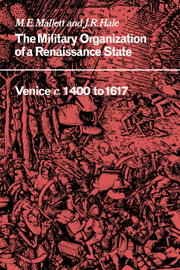Book contents
- Frontmatter
- Contents
- List of illustrations
- Acknowledgements
- References and abbreviations
- Map 1 The Terraferma in the fifteenth and sixteenth centuries
- Map 2 The empire da Mar
- PART I c. 1400 to 1508
- Introduction: the European context 1400–1525
- 1 The beginnings of Venetian expansion
- 2 The composition and role of the army in the fifteenth century
- 3 Military development and fighting potential
- 4 The organization and administration of the Venetian army
- 5 Control and policy making
- 6 Soldiers and the state
- 7 Venice and war
- PART II 1509–1617
- Conclusion: the European context 1525–1617
- Appendix Infantry wages in the sixteenth century
- Select bibliography
- Index
Introduction: the European context 1400–1525
Published online by Cambridge University Press: 22 October 2009
- Frontmatter
- Contents
- List of illustrations
- Acknowledgements
- References and abbreviations
- Map 1 The Terraferma in the fifteenth and sixteenth centuries
- Map 2 The empire da Mar
- PART I c. 1400 to 1508
- Introduction: the European context 1400–1525
- 1 The beginnings of Venetian expansion
- 2 The composition and role of the army in the fifteenth century
- 3 Military development and fighting potential
- 4 The organization and administration of the Venetian army
- 5 Control and policy making
- 6 Soldiers and the state
- 7 Venice and war
- PART II 1509–1617
- Conclusion: the European context 1525–1617
- Appendix Infantry wages in the sixteenth century
- Select bibliography
- Index
Summary
‘It is said that the Venetians in all those places which they are recovering are painting a lion of St Mark which has in its hand a sword rather than a book, from which it seems that they have learnt to their cost that study and books are not sufficient to defend states.’ So wrote Machiavelli from Verona on 7 December 1509 as he watched Venice gradually recover from the shattering blow of Agnadello. His assessment of 1509 as a turning point in Venetian military thinking matches a central theme of this book, but the nature and the implications of that turning point are here perceived in very different terms from those which Machiavelli had in mind. The idea that it was only in 1509 that Venice was forced to consider seriously the military implications of defence of a land empire and to involve itself directly in that defence rather than relying on hired mercenaries is denied by the whole experience of the fifteenth century. Similarly Machiavelli's implication here, more clearly stated elsewhere in his writings, that not just Venice but Italy as a whole had been shocked into a tardy awareness of oltramontane military developments by the thunder of the French guns and the measured tramp of Swiss infantry squares is a view which has to be questioned.
The army which Charles VIII led over the Alps in 1494, with its experienced and permanent heavy cavalry companies, its large contingent of confident and disciplined Swiss pikemen, and its train of horse-drawn guns, was well known to acute Italian observers.
- Type
- Chapter
- Information
- The Military Organisation of a Renaissance StateVenice c.1400 to 1617, pp. 1 - 6Publisher: Cambridge University PressPrint publication year: 1984
- 1
- Cited by



